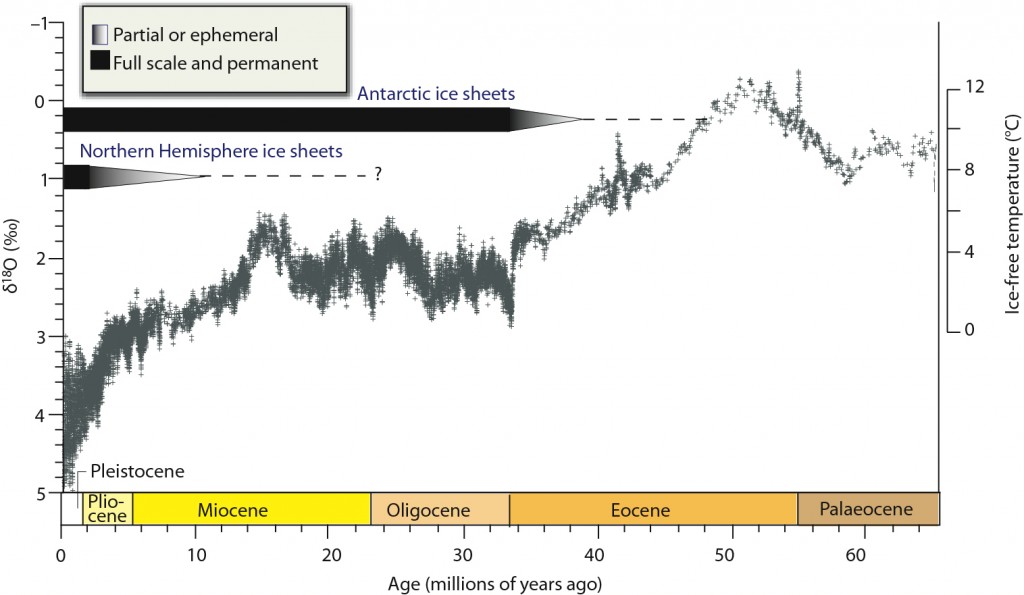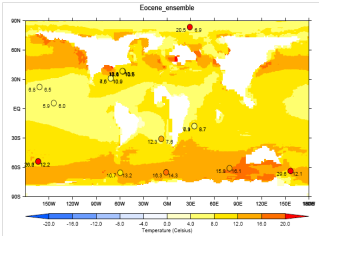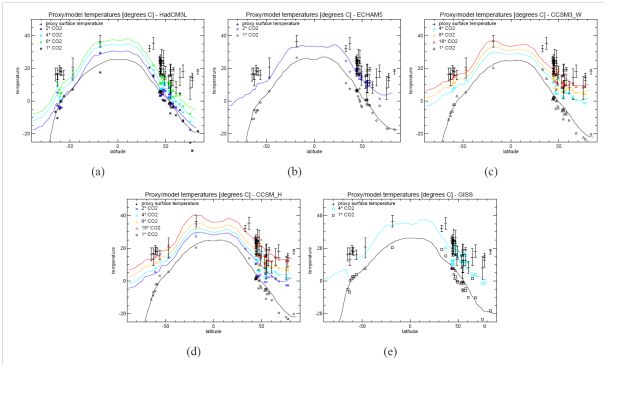Past and Future CO2 – Reconstructing atmospheric Carbon Dioxide
by Gavin Foster, Dana Royer and Dan Lunt

Figure 1: Compilation of available CO2 data for the last 450 million years. For data sources see text. Proxy records are colour coded and labelled in the relevant panel. Greenhouse gas emission scenarios (RCP – Representative Concentration Pathways) used in IPCC AR5 are shown in the right hand panel. Note the variable log scale for time. For the geological data a smoothed line has been fit to the data with an uncertainty accounting for uncertainty in age and CO2. The black line describes the most probable long-term CO2 with 68% confidence limits in red, and 95% confidence in pink.
Carbon dioxide (CO2) in the Earth’s atmosphere is a potent greenhouse gas, responsible for trapping longwave radiation and ensuring the habitability of our planet. Variations in its concentration are thought to be important for controlling the evolution of the Earth’s climate on geological timescales (hundreds of thousands to millions of years) and recent anthropogenic increases in atmospheric CO2 have played a major role in more recent global warming. Read more here.
Reconstructing atmospheric CO2 in the past is a tricky business. For the last 800 thousand years we have bubbles of ancient atmosphere trapped in ice that can be recovered from Antarctica. Prior to this time we have to rely on more indirect methods also known as proxies. Those available to us are discussed in detail in the latest IPCC report, and in particular in Table 5.A.2 in Chapter 5 “Information from Paleoclimate Archives” and more briefly here.
In the Figure 1, we have plotted all the available pre-ice core CO2 reconstructions for the last 423 million years (a total of nearly 800 data points) and compared them to more recent records and projections for the future. The palaeo-CO2 data can be found here, the ice core data here & here , historical data here and the projections of CO2 for the future here.
For the ancient CO2 data there is an increased variability due to the existence of both real short term variability (e.g. orbitally driven change like the well-known glacial-interglacial cycles) and increased noise due to the uncertainty in CO2 reconstructed by these more indirect methods. To account for this and to better reveal the long-term trends in the CO2 data we have fitted a smoothed curve, which has an uncertainty due to the uncertainty on the age and CO2 of each data point. This smoothed curve can be found here (Phanerozoic-CO2). This treatment reveals a number of interesting features:
- Despite considerable variability, there has been a gradual long term decline in CO2 over the last 450 million years or so. On average this is around 13 ppm (parts per million) per million years.
- Values similar to today (398.03 ppm for Feb 2014) were last seen during short intervals in the Pliocene some 3 to 5 million years ago, but the last time long-term mean CO2 was at this level was in the middle Miocene climatic optimum (~16 million years ago; see this blog piece by Paul Pearson for more discussion).
- For much of the rest of the last 450 million years or so Earth generally had higher CO2 than today (with the exception of the Carboniferous-Permian ~300 million years ago where CO2 was once again similar to today).
- Business as usual emission scenarios (RCP8.5 on the figures) indicate atmospheric CO2 will reach around 1000 ppm by around 2110 AD (less than 100 years’ time). The last time CO2 was this high was during the early Eocene Climatic Optimum (EECO)– the warmest time period of the last 50 million years. The planet was so warm during the period that it was completely ice free (sea-level +65 m or so relative to today) and the latest compilations put global temperatures +13 ± 2.6 oC warmer than today (Cabellero and Huber, 2013). It is important to note though that around 5 oC of this warming was due to changes in continental configuration, vegetation and the loss of the continental ice sheets.
- Business as usual emission scenarios (RCP8.5) indicate atmospheric CO2 will reach around 2000 ppm by around 2250 AD. The last time long-term CO2 was at this level was 200 million years ago at the Triassic-Jurassic boundary when CO2 was elevated by the massive outpourings of lava (covering an area of 11 million km2) as the supercontinent Pangaea broke apart and the Southern Atlantic opened for the first time, Read more here.

Figure 2: Climate forcing by changing CO2 and solar output for the last 450 million years. CO2 data and projections are as outlined in Figure 1. Changing solar output calculated as described in Gough et al. (1981; Solar Physics, 74, 21-34) with CO2 forcing from Byrne and Goldblatt (2014; doi: 10.1002/2013GL058456). The red band is the 95% confidence interval around the smoothed line through the published CO2 data.
However, the evolution of climate over this time period is not only being forced by changing CO2. As well as tectonics changing the position of the continents, and changes in vegetation and ice changing Earth’s albedo (its reflectiveness) through time (http://www.scotese.com/), models of stellar evolution predict that the output of our Sun has increased over its life time. On relatively short geological timescales (e.g. the last 5 million years or so) this effect is not significant. But over 400 million years the output of the sun has increased by around 4% (equivalent to ~12 W m-2 of climate forcing). We calculated the climate forcing by CO2 (in W m-2) and the Sun for the last 400 million years (using doi: 10.1002/2013GL058456; see Figure 2).
What is revealed is that despite a dramatic change in solar output, the combined climate forcing by CO2 and the Sun has remained relatively constant (Figure 2). This has been commented on before (here) and is likely due to the operation of a strong negative feedback process changing CO2 levels on geological timescales as a function of global temperature (silicate weathering – more here). However we see that with the latest treatment of the proxy data forcing has remained even more tightly constrained (within ± 5 W m-2) over the last 400 million years (Figure 2). Given this longer term view of climate forcing, the scenarios for future fossil fuel use stand out as being even more extreme, and the business as usual scenario (RCP8.5) would amount to a climate forcing by CO2 that is largely unprecedented in the geological record (as far as we can tell).
Members of the Descent into the Icehouse project are working to improve our estimates of CO2 during the EECO. It is important to note that winding the clock back to EECO CO2 levels in the coming century will not result in a simple return to the Eocene climate. Understanding what drove the evolution of the Eocene climate however will aid our wider understanding of the Earth’s climate system and how it behaves in warm climate states.
Bristol University: Oligocene discussion day
On the 16th of May, the University of Bristol held a half-day meeting devoted to the discussion of the Oligocene epoch (34 to 23 million years ago). The Oligocene is a period of relative climate stability following the establishment of permanent ice sheets on Antarctica (34 million years ago). However, it has received little attention from the Cenozoic palaeoclimate community. The aim of this event was to promote awareness of the Oligocene and encourage future research within this field.
Ellen Thomas, currently in Bristol on sabbatical from Yale, and David Armstrong-McKay, from the National Oceanography Centre (NOC), began the morning session with a series of talks devoted to the late Eocene and early Oligocene. Ellen discussed the Eocene-Oligocene transition (34Ma) from both a modern1 and historical2 perspective while David outlined the competing hypothesis put forward to explain the event3. Dierderik Liebrand, also from the NOC, followed this with a talk on late Oligocene and early Miocene (24-19Ma) cyclostratigraphy4. Following lunch, Bridget Wade gave an hour-long seminar on the Eocene-Oligocene boundary (34Ma)5 and the middle Oligocene (24-30Ma)6. Bridget’s talk doubled as a departmental seminar in the School of Geography.

Figure 1: A compilation of benthic foraminifera oxygen isotope values. During the Oligocene, this reflects a combination of ice volume and temperature7
The event was hosted by Gordon Inglis, a PhD student in the School of Chemistry, and was funded by Professor Rich Pancost (Global Change) and Professor Paul Valdes (School of Geography).
————–
For more information, please consult the following references:
- Liu, Z. et al (2009) Global cooling during the Eocene-Oligocene transition: Science, v. 323, p. 1187-1190
- Kennett and Shackleton (1976) Oxygen isotopic evidence for the development of the psychrosphere 38 Myr ago: Nature, v. 260, p. 513-515
- Merico, A, et al. (2008) Eocene/Oligocene ocean de-acidifiation linked to Antarctic glaciation by sea level fall: Nature, v. 452, p. 979-982
- Liebrand, D., et al. (2011) Antarctic ice sheets and oceanographic response to eccentricity forcing during the early Miocene: Climate of the Past, v. 7, p. 869-880
- Wade, B., et al (2011) Multiproxy record of abrupt sea-surface cooling across the Eocene-Oligocene transition in the Gulf of Mexico: Geology, v. 40, p. 159-162
- Wade, B. And Palike, H., (2004) Oligocene climate dynamics: Palaeoceanography, v. 19, PA4019
- Zachos, et al. (2008) An early Cenozoic perspective on greenhouse warming and carbon-cycle dynamics: Nature, v. 451, p. 279-283
Recovering the Critical Time Interval
These are exciting days for the scientists above JR, on the IODP Expedition 342.
Recovering a complete record of the Eocene and Oligocene when Earth goes from being a really warm greenhouse into an interglacial icehouse mode of climate.
More about the expedition Joides Resolution
Sneak preview of EoMIP modelling study
By Dr Dan Lunt
Part of the ‘Descent into the Icehouse‘ project involves assessing the ability of climate models to reproduce past climates.
This involves comparing model results with reconstructions based on various proxy indicators of climate. Up until now, this has been done in a very ad-hoc fashion, with different modelling groups using different proxy data, and different evaluation metrics. The EoMIP (Eocene Modelling Intercomparison Project), led by project member Dan Lunt, aims to address these issues.
The image below shows early results from EoMIP. Some of the climate models, when high enough levels of CO2 are prescribed, can do a very good job of reproducing the proxy data. However, other models are less successful. As part of the Descent into the Icehouse project, we will be aiming to improve the CO2 estimates, so that model simulations which only give good results with unrealistic levels of CO2, can be rejected, and less weight given to their predictions of future climate .
Descent into the Icehouse
Throughout Earth’s history there have been major reorganisations of the whole Earth system. It is known that the drivers of the changes, and the controls on the intervening periods of relative stability, involve complex feedbacks on a variety of time and space scales between global tectonic cycles, biogeochemistry and evolution which together regulate atmospheric, terrestrial and oceanic conditions.
The “Descent into the Icehouse” project is part of the NERC directed research programme, “Long-term Co-evolution of Life and the Planet”, and addresses the transition of Earth’s climate from “greenhouse” warmth to “icehouse” glaciation during the early Cenozoic era, specifically from around 50 to 34 million year ago.
Due to the nature of the rock record, this most recent transition is the best studied and most well documented of the greenhouse to icehouse switches, but nonetheless the processes responsible are still much debated. The most popular hypothesis is that it was caused by a decline in the atmospheric CO2 – an important greenhouse gas. Although it has been recently confirmed that the final rapid switch at the Eocene/Oligocene boundary was associated with a dramatic decline in CO2, it has also been suggested that CO2 was not the main driver of the overall transition.
A number of potential candidates fall broadly into two camps – either this climate transition was driven purely by processes internal to the Earth (such as mountain uplift, ocean circulation via changes in ocean gateways, or volcanic outgassing of CO2) or it involved some, or all, aspects of the Earth surface, including biology, that can serve to cause and amplify change in a number of important ways. By burning fossil fuels, CO2 concentrations may reach values typical of the greenhouse world of the Eocene by the end of this century. It is therefore becoming imperative to better understand the role of CO2 in driving these natural cycles of Earth’s climate, and consequently, the principal aim of this project is to determine the main driver of this most recent and dramatic switch in climate state.
In order to achieve this we use a multidisciplinary approach that has aspects of both new data collection and computer modelling. We study the fossil remains of sea-dwelling microscopic organisms, the foraminifers and coccolithophorids. These organisms are very abundant in the mud on the floor of the oceans, providing an invaluable archive of past ocean climate data, and by looking at the chemical composition of their shells or the organic compounds they biosynthesise we can determine how warm or how acidic the ocean was.
From such parameters, we can also deduce how much CO2 was in their environment. Armed with this improved understanding of how the climate system evolved leading up to the greenhouse-icehouse transition we can better investigate the natural processes that caused the change. Given the complex nature of the climate system this is best done with a variety of sophisticated computer modelling approaches. Crucially, it is only by guiding these computer simulations with the new data we have generated that we can isolate which of the myriad of potential processes was responsible for triggering this fundamental shift in climate and better determine how they impacted the evolution of life.
Links
Follow us on Twitter
Recent Posts
- In the News : What a three-million year fossil record tells us about climate sensitivity
- Past evidence confirms recent IPCC estimates of climate sensitivity
- Crucial new information about how the ice ages came about : PR & Podcast
- 2014 Sino-UK Coevolution of Life and the Planet Summer School
- Past and Future CO2 – Reconstructing atmospheric Carbon Dioxide







